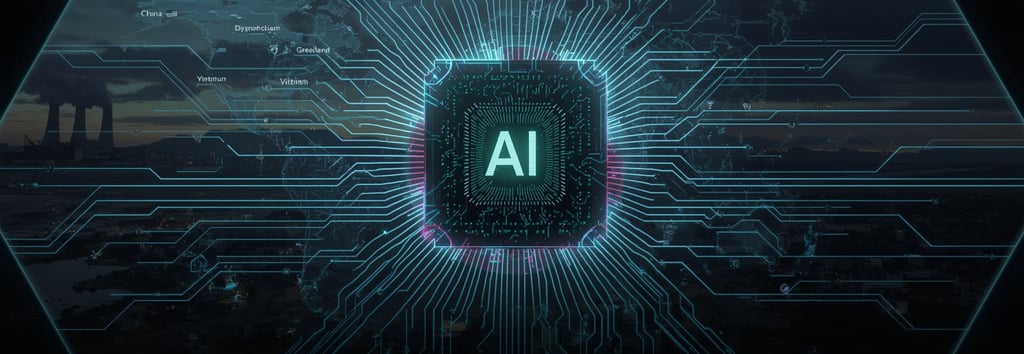
Rare Earth Elements Supply Chain for AI: China, Risks & Solutions
Discover how rare earth elements power AI chips, China’s 80% market dominance, emerging sources, and sustainable sourcing strategies for a resilient global supply chain.


The Hidden Treasure Behind AI Chips
Imagine a world where the future of artificial intelligence hinges on minerals so “common” they’re scattered across the Earth’s crust—yet whose raw power is entwined with trade wars, geopolitical intrigue, and rivers of toxic waste. This is the reality of Rare Earth Elements (REEs), 17 chemical elements that drive everything from hyper‑powerful data‑center magnets to precision camera lenses in autonomous drones. In this immersive deep dive, you’ll discover how China’s iron grip over this market was forged, why every gram of neodymium can be more precious than gold in key applications, and how the AI industry—and perhaps our planet—stands at a pivotal crossroads.
🔑 Key Takeaways
China controls over 80% of global rare‑earth production, setting prices and export quotas.
REEs power high‑performance magnets, precision optics, and even quantum superconductors.
USGS data (2018–2024) reveals a market rising from 170 000 t to 220 000 t, yet vulnerable to shocks.
New sources (Brazil, Greenland, Vietnam, Africa) promise to dilute the monopoly but face environmental and logistical hurdles.
Environmental cost: Baotou (Inner Mongolia) is synonymous with poisoned rivers and radioactive soil.
Rare Earths: Common, Critical—and Controversial
Despite the name, REEs aren’t rare—they’re simply dispersed and costly to extract at scale. The seventeen are: Lanthanum (La), Cerium (Ce), Praseodymium (Pr), Neodymium (Nd), Promethium (Pm), Samarium (Sm), Europium (Eu), Gadolinium (Gd), Terbium (Tb), Dysprosium (Dy), Holmium (Ho), Erbium (Er), Thulium (Tm), Ytterbium (Yb), Lutetium (Lu), Scandium (Sc), and Yttrium (Y). Initially catalysts, today they’re the beating heart of magnets and cutting‑edge optical components. Here’s how applications evolved:
Market in Numbers: USGS Data 2018–2024
In six years, global mine production climbed from 170 000 t to 220 000 t—but with roller‑coaster shifts driven by politics and clean‑energy demand.
2018: 170 000 t
2020: 210 000 t (+23%)
2022: 190 000 t (dip from trade tensions)
2024: 220 000 t (+16% vs. 2018)
China’s Geopolitical Stranglehold
Today, 80%+ of global REEs are mined and processed under China’s control. Decades of state‑led investment—from raw extraction to finished magnets—have secured this dominance.
New Players on the Field
Brazil: 21 million‑ton reserve, but hampered by environmental and infrastructure costs.
Greenland, Vietnam, Africa: Vast potential, 5–10 years from meaningful output.
Baotou’s Toxic Legacy
At Bayan Obo (Inner Mongolia)—the world’s largest REE mine—waste ponds have leaked acid and radioactive sludge:
Cancer rates skyrocketing
Respiratory ailments
Contaminated water sources
From Ore to Chip: The Refining Journey
Extraction: open‑pit & underground mining
Pre‑separation: flotation, magnetic separation
Chemical processing: leaching, precipitation, solvent extraction (high energy demands)
Purification: advanced plants with waste‑management systems
Barriers: colossal capital expenditure, hazardous‑material expertise, stringent regulations.
REEs at the Heart of AI Hardware
The 2021 Supply‑Chain Shock & Chip Shortage
COVID‑19 shutdowns slashed REE output, triggering the 2021 chip crisis and an estimated US$ 500 billion in lost tech revenue.
Trade Wars & Strategic Counters
USA: Tariffs on Chinese REEs + Defense Production Act to stockpile strategic minerals.
China: Export quotas and controls in retaliation.
EU: Strategic Autonomy Initiative funding homegrown REE projects.
ESG & the Green Imperative
Investors demand sustainable, transparent sourcing:
Questions You Didn’t Even Know You Had
Why are REEs vital for AI?
Without their super‑magnets and precision optics, GPUs and AI accelerators simply wouldn’t exist.
How does China’s dominance affect the sector?
By controlling supply, Beijing can throttle or flood the market—exposing the global tech industry to strategic risk.
What’s the environmental toll?
From toxic rivers to sick communities, Baotou’s legacy is a stark warning: the green revolution has a dark underbelly.
Will new sources solve the crisis?
Brazil and Greenland hold promise, but expect 5–10 years before they become reliable suppliers. Until then, the monolith stands.
Conclusion: The Future in Our Hands
Rare earths are the invisible pillars of the AI revolution. Understanding every link—from ore to chip—isn’t just about tracing where your smartphone comes from; it’s about realizing how government policies, corporate strategies, and consumer choices shape our technological and environmental destiny. If we want an AI future that’s both sovereign and sustainable, we must diversify supply, invest in recycling, and hold every actor accountable. This is a battle of vision and will: whoever controls the atoms of tomorrow, commands the world today.
Stay tuned… to be continued.
